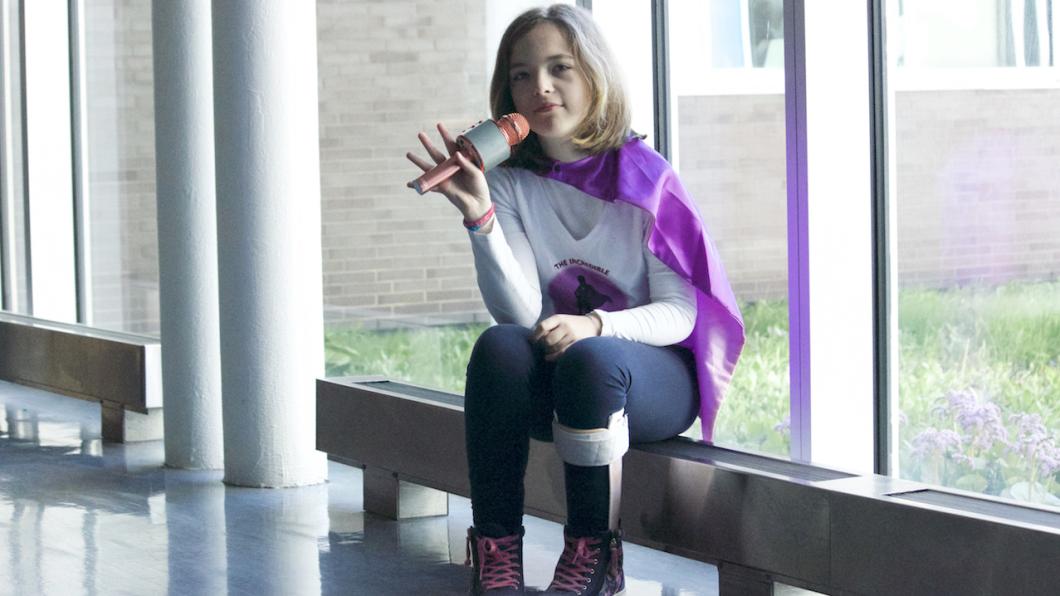
Michelle didn't tell on her bully. Many kids don't
Photo and story by Louise Kinross
Michelle Luis (above) loves to write and sing her own songs. It was during recess when she was “coming up with beats to write” in her head, that a girl from another class began bullying her.
“My friends would be playing sports, and since my balance isn’t 100 per cent, I would be walking in the yard writing music,” says Michelle, now 11, who has cerebral palsy and wears braces.
The bully “would find me and pick on me. She made me feel like I wasn’t worth being in the world because of things she said about my disability. It made me sad and upset. You knock yourself down because of the words the other person is saying.”
It began in Grade 1, and it continued until Grade 4. The bully always targeted Michelle when she was alone.
“I started to pretend I was sick so I wouldn’t have to go to school,” Michelle says. “At one point my mom realized something was wrong and asked me and that’s when I told her.”
Michelle’s mom went to speak with the school principal. "I took books about cerebral palsy for teachers to educate students about," Daniela Luis says. "The students responded very well to the resources and asked many questions to the teachers."
Michelle says the bullying stopped "because everyone was on my side, and no one was on her side."
Michelle gave a talk to her class to explain her disability and used an All About Me book she had made while at the Bloorview School. “After that kids were kind of like okay, she’s different, but then as time went by, they started seeing me as a normal person.”
A bully repeatedly targets and intimidates another child. It could be saying mean things, pushing or kicking, yelling in a child’s face, telling secrets or spreading rumours, not allowing a child to play, or telling other kids not to be friends with someone. Social media has provided a new platform for this aggression.
Michelle has advice for kids who face bullying because of their disability.
“Do your best to stand up for yourself and tell the bully about your differences so they will understand better,” Michelle says. “If they don’t stop, tell a trusted adult who can help you."
Studies show children with a variety of disabilities are more likely to be bullied than nondisabled peers. This 2024 review and analysis of 212 studies in The Lancet found youth aged four to 17 with conditions like autism, ADHD or intellectual disability, or a psychiatric diagnosis, were almost three times as likely to be victims at school. They were also more likely to be perpetrators, or both perpetrators and victims.
"Bullying is a common form of violence among children and adolescents that has been recognized as a major public health concern and is considered one of the most robust preventable risk factors for mental disorders," The Lancet authors write.
The impact of bullying on children’s mental health “is huge,” says Carly McMorris, a clinical psychologist and associate professor at The Enhance Lab at the University of Calgary. For example, “in autistic kiddos we know they are at super high risk for mental health [problems] like anxiety, depression, and suicidality.”
Children may not tell their parents they're being victimized. “Because of their social challenges, children on the autism spectrum may not be clear about what is a typical friendship and what is not acceptable,” Carly says. “Also, often the bully tells the child not to tell anyone, or it will get worse.” Some disabled children don’t have the language to recount what happened.
“Part of the work we do is about empowering our kids, especially those with intellectual disabilities, to understand consent and bullying and boundaries and how to speak up around victimization,” Carly says. “We need to teach about what is a friendship and understanding what is okay and what is not.”
Changes in a child’s behaviour are the most common signs of bullying," Carly says. “Being sick in the morning, not wanting to go to school, or being more socially isolated or irritable,” are examples. Ask your child direct questions, she suggests, like "Is someone being mean to you at school?“ rather than a generic "How was your day?"
PREVnet, a Canadian network of researchers and organizations dedicated to bullying and violence prevention, has some great resources for kids and parents.
This Facts and Solutions page is useful, emphasizing that children need to know it’s not their fault and it's an adult’s job to make the bullying stop. The child, peers, and parents, may have to tell multiple authority figures to put an end to it.
At Holland Bloorview, an anti-bullying working group made up of clinicians and a family leader is hoping to develop a resource for staff to support clients and families when they deal with bullying, which primarily occurs at school.
In addition to reaching out to adults for help, Michelle encourages kids to "do something you love that will take your mind off it.” For Michelle, that was music. “Writing a song will always be a way for me to cope with what happened. Remind yourself that you have people that surround you with love, and you have lots of strengths that make you who you are.”
Michelle was interviewed by CBC about her participation in The Superhero Project, a non-profit that interviews kids with disabilities and illnesses about their strengths, then has artists design a poster depicting them as a superhero. You can listen to Michelle's song about standing up to bullies called 'I'm just like you.'
Like this content? Sign up for our monthly BLOOM e-letter, follow @LouiseKinross on Twitter, or watch our A Family Like Mine video series.